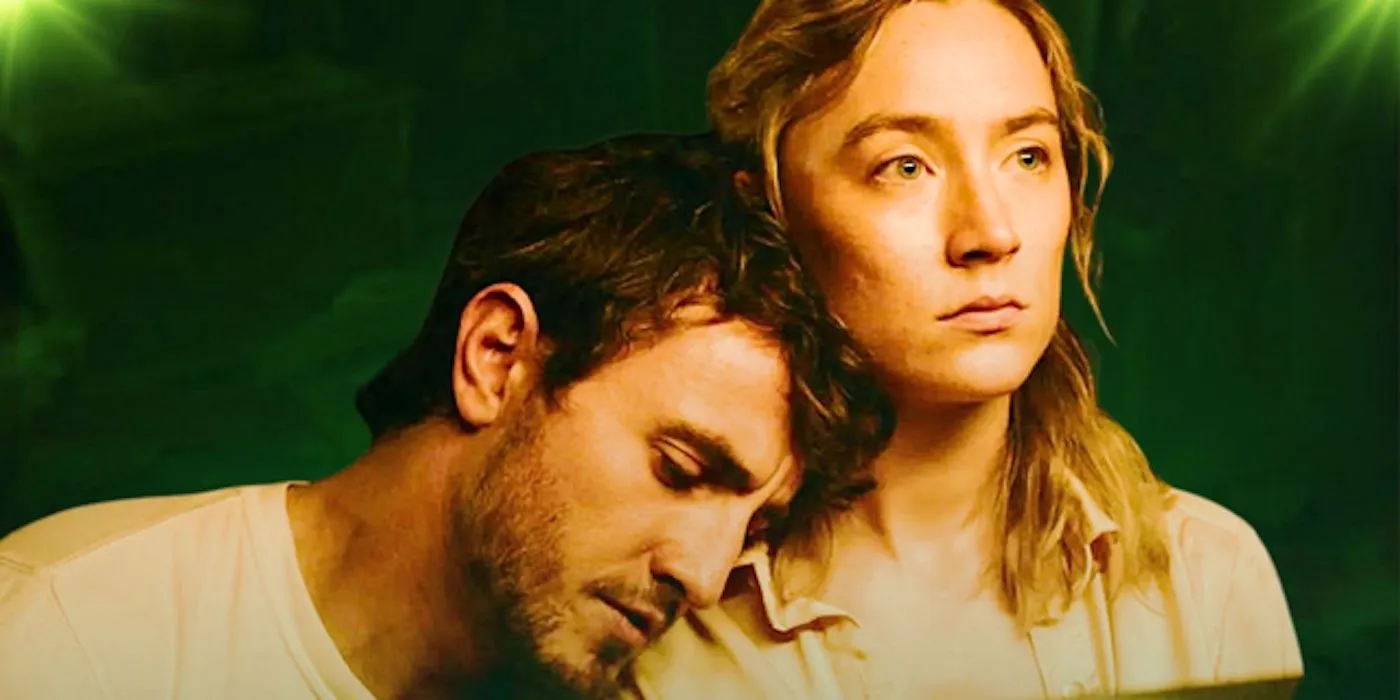The conclusion of Foe might appear intricate at first, but for those familiar with science fiction, the major twist is quite foreseeable. Starring Paul Mescal and Saoirse Ronan, this film is an adaptation of Iain Reid’s novel of the same title.
Reid’s earlier work, I’m Thinking of Ending Things, was transformed into a film by Charlie Kaufman in 2020, though the psychological thriller deviated very well from its literary source.
Unlike that adaptation, Foe, directed by Garth Davis, remains faithful to Reid’s second novel. However, mixed reactions to the 2023 release indicate that this approach may not have resonated with all audiences.

While some adjustments were made to the story, Foe stays largely true to its original plot. The film and book both follow Junior and Hen, a couple residing on a secluded farm in 2065.
When Junior, played by Mescal, is chosen to participate in a project that aims to establish human settlements on another planet, Hen is informed by Terrence, played by Aaron Pierre, that an artificial clone of Junior will keep her company during his absence.
Over the following months, Terrence conducts interviews with both Hen and Junior to ensure that the clone mirrors Junior in every aspect. Eventually, a revelation that many viewers might anticipate takes place.
Foe’s Ending Reveals That Junior Was A Clone All Along
Paul Mescal’s character was never Hen’s actual husband
For those acquainted with common sci-fi tropes, the revelation at the end of Foe may not come as a shock—Junior has always been a clone. Until the final act, the film suggests that Junior has yet to leave Earth and that his conversations with Terrence are part of a process to make his robotic replacement as lifelike as possible.
However, the reality is quite different. Junior had already departed before the events of the movie began, and the discussions with Terrence were tests to confirm whether the clone was functioning properly and maintaining a convincing relationship with Hen. By the end, the real Junior returns, leading to the clone being placed in storage.
Why The Real Junior Replaces Hen With A Clone
Hen is substituted after Junior’s return due to a change in their relationship
As Junior’s clone is deactivated, Hen is visibly devastated, which highlights an unexpected truth—she preferred the artificial version of her husband over the real one.
This leads to complications between the couple in the weeks that follow, as Hen struggles to reconnect with Junior after his two-year absence. A storyline somewhat reminiscent of Black Mirror emerges, where Hen chooses to leave, realizing that her bond with the clone was stronger than with Junior himself.
In response, she is replaced by an eerily accurate replica, who reassures Junior that she will not abandon him. The question of who orchestrated this replacement remains unanswered.
Does Junior Know Hen Is A Clone In Foe’s Ending?
Junior’s unease suggests uncertainty about his wife’s true identity
After Hen’s departure, it would seem logical for Junior to have requested an AI substitute to take her place. Yet, his reaction to the new Hen raises some doubts—his gaze is uncertain, though not necessarily alarmed.
Given that the clone is designed to perfectly imitate Hen, it becomes difficult to determine whether Junior is aware of the swap. It is possible that Hen herself arranged for the transition without informing Junior, rather than him requesting a replacement. There is also a chance that Terrence independently decided to create a new Hen without consulting either of them.
Why Junior Was Sent to Space in Foe
Junior’s journey was part of a broader planetary relocation effort
The events of Foe plays in a version of 2065 where Earth’s conditions are deteriorating due to climate-related disasters. To address this crisis, a large-scale resettlement plan is put into place, aimed at relocating humans to extraterrestrial colonies.
Junior’s two-year mission is part of this initiative, though the film does not delve deeply into the mechanics of this process. The lack of clear details regarding the evacuation plan, the timeline of the planetary migration, or the locations of these colonies might explain why Foe received mixed reactions upon release.
How Foe’s Ending Completely Changes The Opening Scene
Earlier moments in the movie take on new meaning once Junior’s identity is revealed
When Terrence initially informs Hen about Junior’s space mission, he also introduces her to a version of Junior that is actually his clone, without clarifying this detail. By that point, the real Junior has already departed, though this fact remains hidden from viewers until the conclusion of the film.
This revelation reshapes the way the audience perceives the early scenes, as none of Hen’s interactions throughout the movie are actually with her real husband—he was replaced much earlier than the story initially suggests.
Foe Hinted At Its Twist Ending Earlier In The Story
Hen’s behavior towards Junior subtly reveals the truth about his identity
Throughout the movie, Hen exhibits discomfort around Junior and initially treats him like a stranger, hinting that he is not the real version of her husband. An observant viewer might notice early on that Hen’s reluctance to be close to Junior becomes apparent soon after Terrence enters their lives.
This small but telling detail diminishes the element of surprise in the final twist, making it less shocking than it might have been otherwise. While this type of plot could have been reminiscent of The Twilight Zone, the film’s heavy foreshadowing makes it difficult to conceal its core mystery for its nearly two-hour duration.
The Real Reason Terrence Keeps Interviewing Hen and Junior
Terrence’s role is more about monitoring the clone than creating it
Terrence presents himself as someone refining Junior’s AI replica through continuous observation and questioning. However, his actual purpose is to assess whether the clone is aware of its nature and to evaluate its responses in a series of psychological tests.

The increasing tension between Hen and Junior’s clone, particularly as Hen and Terrence grow closer, makes more sense when considering that Hen is not actually with her real husband. Since she recognizes this fact, she has little concern for how the clone might react to her interactions with Terrence.
What Foe’s Ending Really Means
The film questions how well people truly understand each other
At its core, Foe looks into the idea of individuals seeking out idealized versions of their partners, only to struggle when reality does not align with their expectations.
The names “Hen” and “Junior” themselves are abbreviations and nicknames rather than full names, which subtly suggests that neither character saw the other as a complete and distinct individual.
Given this, it becomes unsurprising when both of them abandon their partners after experiencing the appeal of artificial replacements at different points in the story.



